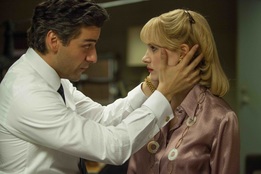 Charles Harris As I said in previous articles, I suggest approaching a second draft screenplay as a number of mini-drafts, each focusing on a different aspect. After revising structure and character, we're now ready to turn to the individual scenes. The advantage of this approach is that you don't have to worry about details when you're still working on the larger picture. It would be pointless, for example, to spend time polishing a scene that may disappear if you later changed the overall structure or revised a key character. The Scene Draft For this draft, you work through the script scene by scene, starting with the first. Read each through a number of times. Look for where the scene works best and where it falters. Is it too long - or too short? Does it work dramatically or is it flat? Good scenes are the powerhouse of your script - but poor scenes will suck out the energy! Watch out especially for scenes that are "setting things up". These are very off-putting, both to a reader and to the ultimate audience. If you find a Setting-Up scene - and you'll doubtless find many - ask yourself if you can give it a dramatic point. Can you bring out some element of conflict or put at least obstacles in the protagonist's way?  Can you build the emotion - whether comedy, tragedy or thriller? If not, then you'll probably need to axe the scene entirely and leave the information till later - or cut it out entirely. Writers often become over-anxious about telling the audience things. Questions are more important than answers. Build up questions in the viewers' minds and they will be drawn into the story - and want to find out what happens next. Short and sweet Most early draft scenes will need to to be shortened, often dramatically. A good movie scene is usually short and contains a single dramatic beat - that is to say: one dramatic change. For example, at the start of the scene, the heroine may be desperately trying to find a lost key, by the end she's succeeded or failed. There may be a few major scenes that contain more beats, but keep them to a minimum. TV scenes may contain more than one beat, as there is generally less money for sets and locations, but even so the beats will be limited. Otherwise your script risks turning into a stage play. Be ruthless. Find the heart of the scene and get to it quickly, cutting out any preamble. The best scenes dive straight to the heat of the action. And end rapidly - so eradicate any winding down. All those "hellos" and "goodbyes" should go into the trash bin. You'll be surprised how much tighter and more energised your script becomes. Who's in charge? Now, decide who the protagonist of the scene is. It's usually the protagonist of the story as a whole, but not always. Make sure that she pushes the scene forwards, taking action to overcome obstacles. This may mean giving her a goal in the scene (which will normally involve planting this in a previous scene). Or it could mean adding new obstacles. Or ensuring that she takes action and doesn't leave it to someone else. Variety is the spice of life Next look at variety and pacing. Ideally each scene should be different from the scenes before and after - either faster or slower or funnier or more tense, etc. As with characters, in the last article, look to see if you have two or more scenes performing the same function. You'll often find that you've written a number of quite different scenes that essentially do the same thing. Three scenes which show the protagonist saving a dog, defending a work colleague and giving money to a Big Issue saleswoman may all be there to show his positive side. Decide which is the most interesting and delete the rest. And just as some characters work better when combined into one, the same can apply to half-decent scenes. Often, one really strong scene can emerge from elements from a number of scenes that weren't working on their own. Many layers make scenes work Once a scene has been trimmed down and possibly combined with others, look finally at layering in some more elements to make it even better. Good scenes are generally multi-layered. While pushing the story forwards, they surreptitiously slip in other material that can, for example, set up future issues, deepen character or enrich the theme. Early in the film Nightcrawler, petty thief Lou comes across a burning car on a freeway. Cops are trying to pull the driver out. As Lou watches, intrigued, a TV news crew arrives to film the incident and he asks a few questions. It's a simple scene, but does everything we've seen above. It starts the moment he pulls his car over and gets out. Immediately we are plunged into the action of the attempted rescue. He wants to know how the TV crew work but the script provides obstacles, making the cameramen preoccupied and brusque in their answers. It is faster paced than the scene before and after. And despite the simplicity of the action, it provides many deeper layers - developing Lou's character, setting up the idea of filming death and injury for TV, his future competitors and the mechanisms and the ethics involved. (You can read the screenplay here - the freeway scene starts on page 4). Focus Whereas I suggested writing the first draft quickly, jumping over any gaps, this fourth mini-draft should be painstaking and focused, ensuring that each scene is structured in the best possible way. Once you've done that for every scene in the script, you can move on to the dialogue and description, which we'll be dealing with in mini-drafts five and six... <Previous article Next article> Charles Harris new book Jaws in Space: Powerful Pitching for Film and TV was published last month by Creative Essentials and is already recommended reading on MA courses. You can buy it here and get the e-book version included for free.
7 Comments
by Ian Long David Robert Mitchell's 2014 film "It Follows" appealed to an audience well beyond 'genre' fans (see the endless blog posts and Youtube clips interpreting the story as evidence). But why did this particular film raise so much interest? And what can writers working in Horror (and other genres) learn from it? The story centres on a young woman (Jay) and her group of friends, who are menaced by a relentless, murderous, shape-shifting threat. In terms of genre, then, it's essentially a "Teen Slasher" film. In these films, groups of young people are menaced by monsters, dying one by one in horrific circumstances. Characterisation is fairly thin, and the first to go is often a sexually active girl (the films tend to conform to a specific moral code). Let's look at what opened this film up to a wider audience.
What does this tell us about It Follows?
It's useful to think of films in terms of style and tone as well as genre, and these elements suggest that, as well as Horror, It Follows is an Arthouse film. Arthouse/Indie Style
And maybe we're more ready to accept 'fantasy' storylines when they're presented in these terms? Let The Right One In - a precursor It Follows took its cue from Swedish arthouse vampire film Let The Right One In, acknowledging the debt by staging its climax in a swimming-pool, like the earlier film. In both cases, the filmmakers took a long, hard look at their genre and asked which elements need to remain, and which have become stale conventions which should be ditched. All filmmakers need to do something similar. Conclusion - the Joys of Arthouse Arthouse is cheap, intelligent, critically attractive, and can punch far above its weight in terms of international acclaim. It actively embraces 'foreign' (non-English language) films, opening the door to recent Arthouse Horrors like A Girl Walks Home Alone At Night, Troll Hunter, Let The Right One In, etc. Giving your story an Arthouse twist should make you think through its ingredients in a very rigorous way. SPOILER ALERT: and, despite having early sex scene, Jay isn't singled out for narrative punishment - she's still alive at the end of the film. LEARN MORE ABOUT REFRESHING YOUR HORROR WRITING AT MY WORKSHOP - LONDON, OCTOBER 29 Click here to read about it. |
BLOGTHE ONLY PLACE TO TALK ABOUT THE CRAFT OF SCRIPTWRITING.
|
Privacy Policy © Euroscript Limited 2020


 RSS Feed
RSS Feed


